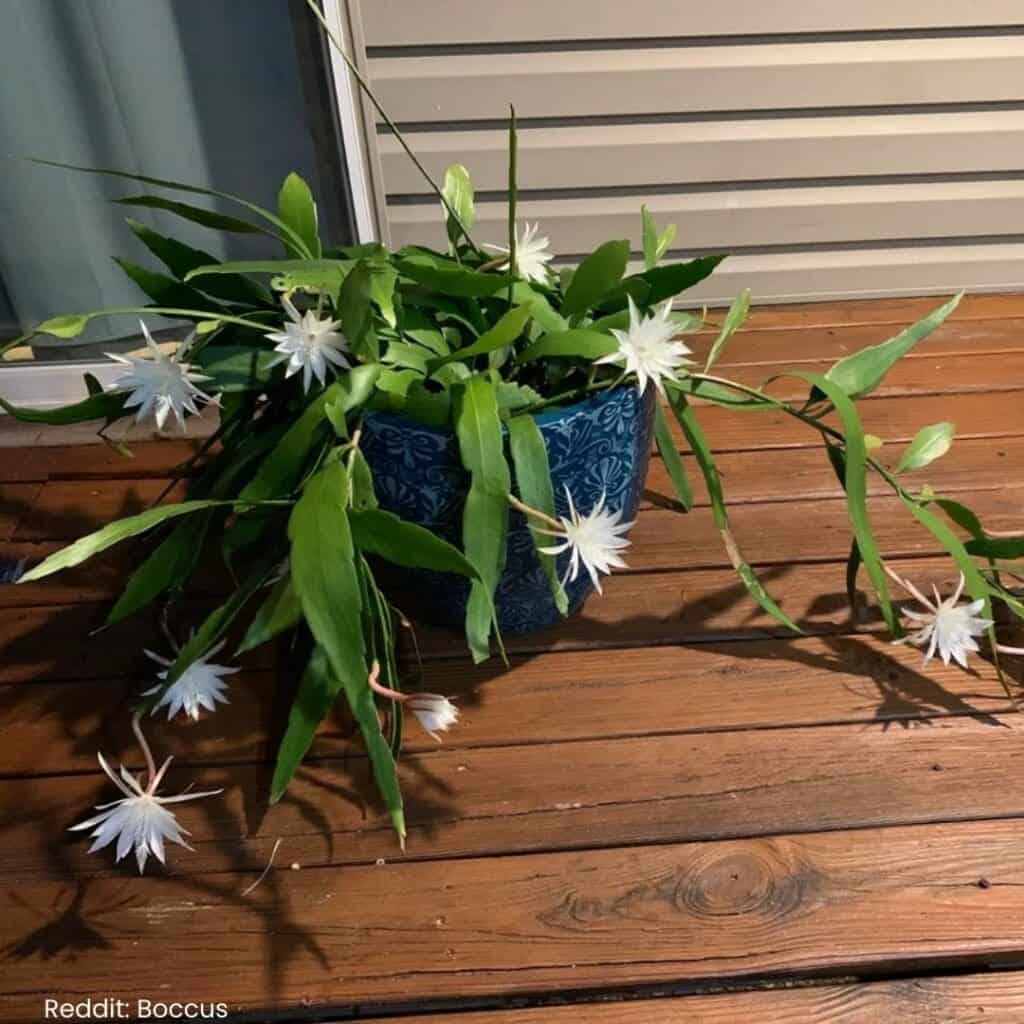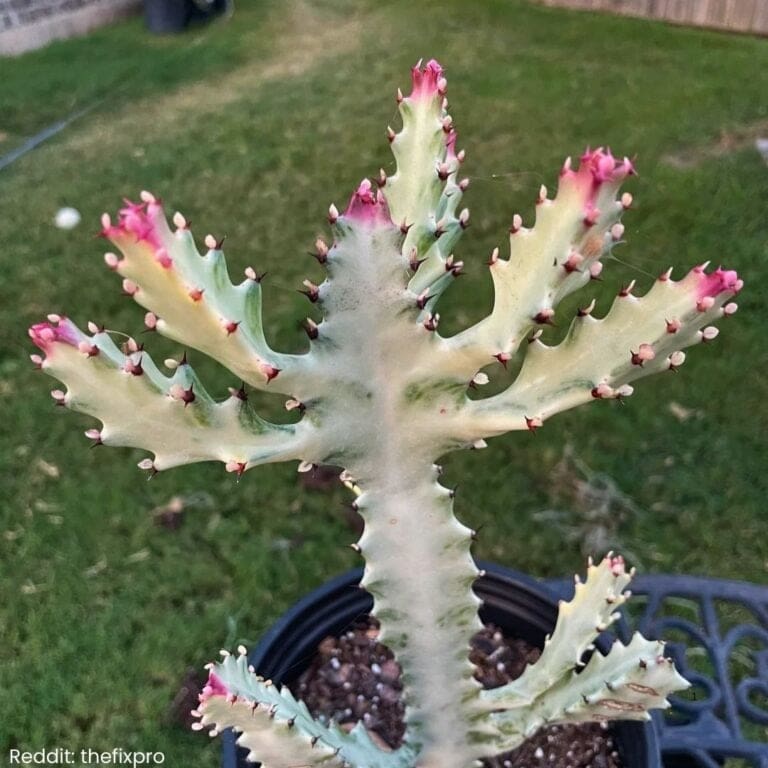11 Tips To Care For Orchid Cactus And Help It Thrive
I just love how unique orchid cactus plants are, with those long, trailing stems and wild, colorful blooms.
They really bring a splash of tropical energy into any room, but honestly, keeping them happy does take a bit of practice.
Over time, I’ve picked up a bunch of straightforward tricks—from getting the light right to fussing with the soil—that make orchid cactus care way less intimidating.
Each little tweak helps build a routine that keeps them looking their best and ready to show off those show-stopping flowers.
Please note: Simplify Plants is reader-supported. As an Amazon Associate, I earn from qualifying purchases made by our readers with no extra cost added to you all! Some links in the post are affiliate links and I get a commission from purchases made through links in the post.
1) Place orchid cactus in bright, indirect light

I always try to keep my orchid cactus somewhere with bright, indirect light. It really seems to help the stems stay healthy and makes blooms more likely. Direct sun? Nope, learned the hard way that it can scorch those leaves.
Usually, I’ll set mine a few feet from an east or north-facing window. That way, it gets enough light without getting fried. If things seem a bit too intense, I’ll just throw a thin curtain over the window.
When my cactus isn’t getting enough light, I notice the stems get kind of thin and pale. That’s my cue to scoot it closer to the window. Balanced light really keeps the plant looking strong and green.
In winter, the days are short, so sometimes I’ll use a little grow light. I’m careful not to put it too close—don’t want to cook the plant. A few extra hours of light can perk it up.
The sun’s angle changes during the year, so I check the lighting every so often. Adjusting where the plant sits helps avoid burns or too much shade.
Finding that perfect light spot takes some trial and error, but once I nail it, my orchid cactus just looks so much better.
2) Use a well-draining cactus mix for soil
I’m picky about soil—my orchid cactus always goes in well-draining soil. It’s just way better for the roots and stops them from sitting in water, which they really hate.
I usually grab a cactus or succulent mix because it drains way faster than regular potting soil. Most of those mixes have perlite, pumice, or coarse sand in them, which helps water run through.
Sometimes I’ll mix up my own blend at home. I like equal parts cactus mix, orchid bark, and a bit of peat moss. It’s loose and airy but still holds just enough moisture.
I always double-check that my pot has drainage holes at the bottom. Even the best soil can’t save the roots if water just sits there. No holes? Not worth the risk.
When I water, I let the extra water drain out completely and never let it sit in the saucer. That little habit keeps things fresh and helps my orchid cactus thrive.
The right soil really does make a difference. It supports strong roots, healthy growth, and, honestly, way more blooms. Good drainage is everything for this plant.
3) Water thoroughly when top inch of soil is dry

I always poke a finger into the top inch of soil before watering my orchid cactus. If it’s dry, that’s my green light. If it’s still damp, I just wait a bit longer. This helps keep root rot at bay.
When it’s time to water, I soak the soil until water runs out of the drainage holes. That way, the roots get enough but aren’t left swimming. I always dump out any leftover water from the saucer—soggy roots are bad news.
My orchid cactus seems happiest when I keep up with this routine. Consistent watering leads to fuller growth. Letting the soil dry out a bit between waterings keeps the roots breathing.
In summer, I check the soil more often because it dries fast. When it’s cooler, I back off and water less. Changing things up with the season keeps my plant on track.
I stick to room-temperature water—cold water can shock the roots, and hot water? Definitely not. It’s a small detail, but it really helps keep my orchid cactus looking good.
4) Avoid overwatering to prevent root rot
One thing I’ve definitely learned: orchid cacti hate soggy soil. Their roots need air, and too much water just suffocates them. If the soil stays wet, the roots start to rot and the plant goes downhill fast.
I always check that top inch of soil before watering. If it’s dry, I give it a drink; if not, I wait. It’s a simple routine that really works.
My pot has drainage holes so water can escape. Even if I’m careful, a pot with no drainage is just risky. I also make sure to empty saucers so water doesn’t pool around the roots.
When it’s cooler, I water less because the plant slows down. In summer, I check more often since the soil dries out faster.
I notice that good light and airflow help the soil dry evenly. A spot with gentle light and some air movement keeps things healthy.
Paying attention to moisture and drainage is honestly the easiest way to avoid overwatering and root rot. It’s a must for keeping my orchid cactus around for the long haul.
5) Provide humidity around 50-70%

I’ve found that orchid cacti really like a bit of humidity. When the air’s too dry, the leaves shrivel or get brown tips. Keeping things between 50% and 70% makes a big difference.
Usually, I’ll run a small humidifier nearby, especially in winter when it gets super dry inside. It’s easy and doesn’t make the whole place feel damp.
Sometimes I’ll mist the plant lightly in the morning, just for a quick boost. But I don’t overdo it—too much water on the leaves can cause rot.
If I don’t have a humidifier handy, I’ll set the pot on a tray with pebbles and water. As the water evaporates, it bumps up the humidity right around the plant. I just make sure the pot’s not sitting in the water itself.
I keep my orchid cactus away from heaters or vents. Those dry out the air fast and can really stress the plant. A steady spot helps it grow and bloom better.
To keep tabs on humidity, I use a cheap hygrometer. It’s easier to fix things before the plant starts looking sad.
Getting the humidity right keeps the leaves plump and green. It really brings out the best in the plant.
6) Feed monthly with a balanced, water-soluble fertilizer

During the growing season, I feed my orchid cactus once a month. Balanced, water-soluble fertilizer seems to do the trick. I look for equal numbers on the label, like 10-10-10 or 20-20-20.
I always dilute the fertilizer to half strength. These plants don’t need much, and too strong a mix can burn the roots. I just mix it with water and pour it around the soil.
When fall and winter roll around, I stop feeding. The plant’s not growing much then, so extra fertilizer just stresses it out. Once spring hits, I start up again.
I’ll sometimes use a fertilizer made for orchids or succulents. As long as it’s balanced and water-soluble, it works. Consistency matters more than the brand, honestly.
If I notice pale leaves or slow growth, I check if I missed a feeding. Regular nutrients help the cactus put out strong stems and more blooms. Good feeding habits really pay off.
7) Repot every 2-3 years in spring
Every couple of years—or three, if I forget—I’ll repot my orchid cactus. It helps keep the roots from getting cramped and just gives the plant a fresh start. Spring is my go-to time since that’s when new growth kicks in.
When I repot, I take the plant out gently and shake off the extra soil. I’ll trim any roots that look mushy or rotten. It’s a good way to dodge root rot and keep things tidy.
I pick a pot just a bit bigger than the old one. Too much room means extra moisture, which isn’t great. Drainage holes are a must.
For soil, I stick with a light, well-draining mix. Something for epiphyllum or cactus plants works. Sometimes I’ll add orchid bark or perlite to keep things airy.
After repotting, I wait a few days before watering, just to let the roots heal. Then I water lightly and put the plant back in bright, indirect light so it can settle in.
Repotting really seems to give my orchid cactus a boost. It grows stronger and blooms better after a fresh start.
8) Use a pot with drainage holes

I never skip the drainage holes when picking a pot for my orchid cactus. They let extra water escape and stop the roots from sitting in wet soil. Once roots start to rot, it’s tough to save the plant.
When I water, I like seeing water run out the bottom. It means the soil’s moist but not waterlogged. Good drainage is key for strong roots.
I steer clear of pots without holes, even if they’re pretty. If I want a decorative look, I’ll put the plain pot with holes inside a nicer outer pot. That way, I get both style and function.
I make sure the potting mix drains well, too. A well-draining mix is closer to what orchid cacti get in nature—on trees or rocks where water doesn’t stick around.
If I see water pooling at the bottom, I check that the holes aren’t blocked. Sometimes soil or roots clog them. Keeping them clear helps air get to the roots and stops mold or fungus.
I pick a pot just a bit bigger than the root ball. If it’s too big, it holds extra moisture and dries out slowly, which can cause problems.
Using a pot with drainage holes just makes watering safer. It’s the simplest way to protect my orchid cactus from overwatering and keep it going strong all year.
9) Prune spent flowers to encourage new blooms

I try to remove old or wilted flowers as soon as they fade. It just keeps my orchid cactus looking tidy and lets it focus its energy on new growth instead of wasting it on drying blooms.
When I cut off spent flowers, I grab clean, sharp scissors or pruning shears. I usually snip just above a healthy segment of the stem—no need to get fancy.
I never pull or twist flowers off by hand. That can tear the stem and slow down recovery, which nobody wants. A quick, clean cut helps the plant heal faster and just stay healthier overall.
After pruning, I’ll check for any soft or damaged stems and trim those too. Getting rid of weak parts improves air flow and light exposure, which always seems to help with future blooms.
Oh, and I like to wipe my tools with alcohol before and after pruning. It’s a simple step, but it keeps bacteria and fungus from spreading between cuts.
Pruning doesn’t take long, honestly. My orchid cactus often rewards me with fresh buds and stronger blooms in the next cycle—kind of makes the effort worth it.
Keeping up with this small task just helps my plant stay vibrant and ready to bloom again.
10) Keep temperature between 60-75°F (15-24°C)
I try to keep my orchid cactus in a comfortable temperature range of 60-75°F (15-24°C). This range keeps the plant happy and helps prevent stress.
When the temperature stays steady, the cactus grows better and the stems look stronger. If it gets too cold, my plant slows down and may stop growing altogether.
I avoid letting it drop below 50°F (10°C), especially at night. Cold drafts from windows or doors can be a problem, so I keep it away from those spots.
When it’s too hot, the leaves can wilt or dry out. I’ll move my plant to a cooler spot or give it a little shade during hot afternoons, and I check the soil more often since heat dries it out faster.
Honestly, indoor temperatures usually work just fine for orchid cactus care. Adjusting the thermostat or moving the plant to a different room is usually enough.
During season changes, I pay attention to how the room feels. If I need to open windows in summer or use heaters in winter, I make sure the plant isn’t directly in the airflow.
With steady temperatures, my orchid cactus looks greener and more vibrant. Stable warmth helps it stay strong and ready to bloom.
11) Avoid sudden temperature changes

I’ve noticed that orchid cacti don’t like surprises, especially with temperature. They just seem happier when the air stays steady and mild.
Sudden heat or cold can stress the plant and cause buds to drop. I always keep my orchid cactus away from drafts, open windows, and air vents.
Even a quick blast of hot or cold air can really shock it. I also avoid putting it near heaters or air conditioners—just not worth the risk.
If I want to move the plant outdoors, I do it slowly. I let it adjust to new temperatures a little at a time, maybe a few hours outside each day so it can adapt without trouble.
If the nights get chilly, I bring it back in before the temperature drops too much. Consistent warmth and gentle changes keep my cactus healthy and blooming.
By watching the temperature and making little adjustments, I help my orchid cactus avoid stress and stay strong.
Understanding Orchid Cactus Needs
I try to keep my orchid cactus healthy by giving it the right light, temperature, and soil conditions. These details really make a difference in how well it grows and blooms.
Light and Temperature Considerations
I keep my orchid cactus in bright, indirect light. Direct sunlight can burn its leaves, but too little light makes it weak and stops flowering.
A spot near an east- or north-facing window usually works best. During the day, I aim for temperatures between 65°F and 80°F (18°C–27°C).
At night, a slight drop helps the plant rest. I avoid placing it near heaters, vents, or cold drafts since sudden changes can stress it out.
In winter, I let it experience cooler nights—around 55°F (13°C)—to encourage blooming later. If I see yellowing or limp leaves, that’s usually a sign it’s getting too much sun or cold air.
When growing indoors, I sometimes use a sheer curtain to filter sunlight. It keeps the light gentle but steady, which helps the cactus keep its color and shape.
Soil and Potting Mix Essentials
I use a well-draining mix since orchid cacti just hate sitting in water. A mix of orchid bark, perlite, and peat moss gives the roots both air and moisture—regular potting soil holds too much water and can cause rot.
Before potting, I always make sure the container has drainage holes. Water should flow out easily after each watering.
If I notice soggy soil, I’ll repot with fresh, dry mix. I feed my plant with a balanced, diluted fertilizer every few weeks during spring and summer—just enough to support strong growth without overwhelming the roots.
Here’s a quick reference:
| Material | Purpose |
|---|---|
| Orchid bark | Air circulation |
| Perlite | Drainage |
| Peat moss | Moisture retention |
Keeping the soil loose and airy really helps my orchid cactus thrive year-round.
Common Orchid Cactus Problems
I’ve noticed orchid cacti can run into trouble when their care routine slips. The most common issues come from stress, pests, and diseases, which tend to show up through changes in color, texture, or growth.
Paying attention early helps me fix problems before they get worse.
Recognizing Signs of Stress
If my orchid cactus looks droopy or shriveled, I check water levels first. Too much water leads to root rot, while too little makes stems wrinkled and soft.
I also watch for yellowing or browning edges—usually a sign of too much direct sunlight or maybe fertilizer burn. If growth slows or new stems look thin, it probably needs more bright, indirect light or a little balanced fertilizer.
Here’s a quick guide I use:
| Symptom | Likely Cause | Simple Fix |
|---|---|---|
| Wrinkled stems | Underwatering | Water thoroughly, then let soil dry slightly |
| Mushy roots | Overwatering | Trim roots, repot in airy mix |
| Pale color | Low light | Move near bright window |
| Brown tips | Too much sun or fertilizer | Reduce exposure or feeding |
By checking these signs often, I can keep my plant healthy and growing strong.
Preventing Pests and Diseases
I’ve found that cleanliness and airflow are key to keeping pests away. I wipe leaves gently with a damp cloth and remove dead stems so insects have nowhere to hide.
Common pests like mealybugs, spider mites, and scale sometimes show up if humidity is high or air is still. I inspect under leaves weekly and use insecticidal soap if I see sticky residue or white fuzz.
To prevent disease, I always use sterile pruning tools and avoid letting water sit on the stems. Good drainage really helps stop fungal infections from starting.
If my plant ever looks off, I isolate it from others until I’m sure it’s safe. A few simple habits keep my orchid cactus free from most problems.
Frequently Asked Questions
I keep my orchid cactus healthy by focusing on watering, lighting, soil, and humidity. I also check for pests, repot when needed, and prune to encourage blooms. Each step helps the plant stay strong and look its best.
What’s the best way to water my orchid cactus to keep it healthy?
I water my orchid cactus when the top inch of soil feels dry. I pour water until it drains from the bottom, then let the pot dry before watering again—this keeps the roots healthy and prevents root rot.
How often should I fertilize my orchid cactus, and what type of fertilizer works best?
I use a balanced, water‑soluble fertilizer once a month during spring and summer. I mix it at half strength to avoid burning the roots. In fall and winter, I stop fertilizing to let the plant rest.
Can you give me some tips on the ideal lighting conditions for an orchid cactus?
I put my orchid cactus in bright, indirect light. Direct sunlight can burn the leaves, so I keep it near a window with filtered light. If it looks pale or stops blooming, I move it to a brighter spot.
How do I know if my orchid cactus needs repotting, and how should I do it?
I repot every 2 to 3 years or when roots start poking out of the drainage holes. I use a well‑draining cactus mix and a pot with holes, gently remove the old soil, trim damaged roots, and place it in fresh mix.
What are the common signs of pests or diseases in orchid cacti, and how can I treat them?
I look for mealybugs, scale, or soft spots on the stems. If I spot pests, I wipe them off with a cloth dipped in rubbing alcohol. For root rot, I trim the damaged roots and let the plant dry before replanting in fresh soil.
Could you share some advice on how to prune an orchid cactus to promote blooming?
I usually prune after the orchid cactus has finished blooming, snipping back those long or skinny stems. This tends to make the plant bushier and, honestly, seems to coax out more flower buds the next time around.
I always grab clean scissors for the job—nobody wants to deal with a sick plant because of dirty tools.
Recommended Garden Supplies
| Product Image | Our Recommended Gardening Supplies | Check Offers! |
|---|---|---|
Top Top
Top
Top
Top
Top
Top
Top
Top | rePotme Houseplant and Tropical Classic Potting Soil Mix | Check Offer On Amazon |
 Top
Top
Top
Top
Top
Top
Top
Top | Espoma Organic Indoor Plant Food | Check Offer On Amazon |
 Top
Top
Top
Top
Top
Top
Top
Top | GooingTop LED Grow Light 6000K Full Spectrum Clip Plant Growing Lamp | Check Offer On Amazon |
 Top
Top
Top
Top
Top
Top
Top
Top | Soil Moisture Meter | Check Offer On Amazon |
 Top
Top
Top
Top
Top
Top
Top
Top | Govee Hygrometer Thermometer, Bluetooth Enabled! | Check Offer On Amazon |
 Top
Top | LEVOIT Humidifiers for Large Room(Best For Plants) | Check Offer On Amazon |
 Top
Top
Top
Top
Top
Top
Top
Top | Upgraded DIY Automatic Drip Irrigation Kit, 15 Potted Houseplants Support | Check Offer On Amazon |
 Top
Top
Top
Top
Top
Top
Top
Top | Stainless Steel Heavy Duty Gardening Tool Set | Check Offer On Amazon |
 Top
Top
Top
Top
Top
Top
Top
Top | Bonide Insecticidal Soap | Check Offer On Amazon |
 Top
Top
Top
Top
Top
Top
Top
Top | Bonide 32 oz Spray Neem Oil for Organic Gardening | Check Offer On Amazon |
 Top
Top
Top
Top
Top
Top
Top
Top | Garden Safe Fungicide | Check Offer On Amazon |
Note: Some images in the articles are sourced from Reddit and Other Platforms For Reference Purpose.






